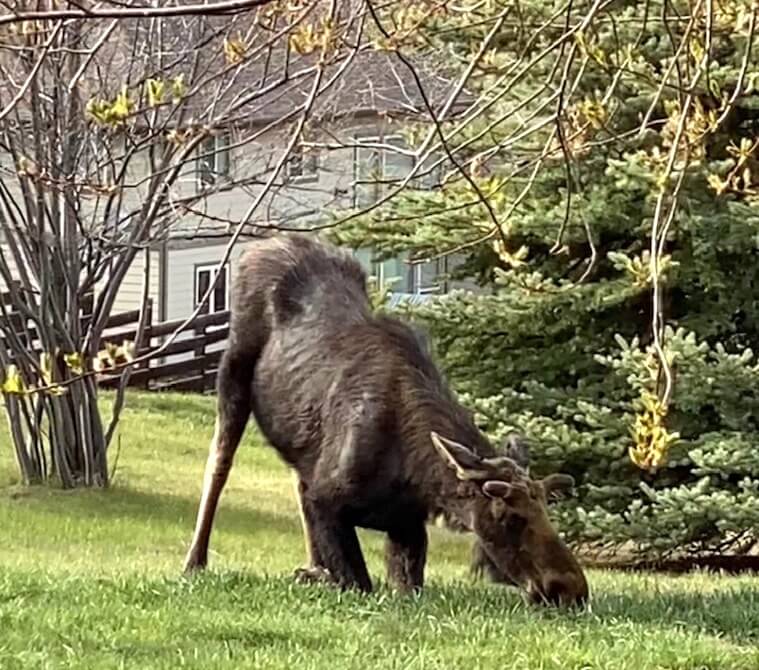Is That a MOOSE?
By Lynn Arthur
Broadcast 5.24 & 5.27.2023

The kneeling moose. Photo © Lynn Arthur.
Listen:
Is that a moose in my yard? A moose??
Closing my front door, I caught sight of a large dark animal moving among the trees in my yard. I saw small velvet antlers…a bull moose. Ribs visible under his patchy winter coat, his singular focus on biting the budding leaves of the aspen and chokecherry. I didn’t know if he saw me on my porch but he now had a rapt audience of one—me! Wild animals—deer, fox, coyote—are frequent visitors to my yard, but this was the first moose. Why was he here?
The foothills between Bozeman and the Bridger Mountains are not typical “moose territory” with wetlands and willows, ponds and meadows. My neighborhood, a collection of homes built over 25 years, sits on the ridges and swales of former dryland wheat fields. Even in May, when yard trees are leafing and grass growth is surging, this is not “moose territory.” I was delighted to observe such an unusual visitor, but he had a bigger surprise for me. As I watched him forage through my yard he did something unique I had never seen, heard of, nor even imagined!
In a grassy area, bending forward at the neck, he bit off the tallest blades of grass. Much more grass beckoned, but was shorter in length. He struggled to get his mouth to this shorter grass. Deer and elk easily lower their heads to bite grass. Why was this a struggle? Watching, I realized it takes extra effort for moose to do the same thing because their front legs are longer than their back legs. This creates a moose’s unique shoulder hump. Longer front legs are beneficial to a moose’s survival: they browse tree leaves higher than other animals, walk easily through deep snow, and jump and run over obstacles to evade predators. However, these long front legs create an obstacle to grazing near the ground.
How can a moose graze on grass when his neck is unable to reach past his front legs? I witnessed several approaches. First, this moose awkwardly spread his front legs wide apart and extended his neck down (envision a giraffe drinking). He stayed in this position long enough to grab several bites of grass. Next, he sort of crouched down, offsetting his front legs from each other and slightly bending both knees. This approach worked for a few more bites of grass. Finally, he bent one front knee and carefully placed it on the ground, followed by the other knee. He was kneeling! He proceeded to methodically eat all the grass he could reach within a semi-circle around his knees. I thought, “Now what does he do? Get up?” Nope! He “walked” forward on his knees until he reached a new area of grass and returned to his semi-circle pattern of grazing. He did this several times!
Now I was puzzled. Do moose usually eat grass or other vegetation that is close to the ground? We commonly see images of moose browsing on shrubs or standing in water with dripping vegetation hanging from their mouths, but I had never seen an image of a moose on its knees.
Moose are herbivores—plant eaters—and the word “moose” is an Algonquin term meaning “twig-eater.” During the harsh winter months moose will lose 30 percent of their weight from the poor quality of vegetation they consume—dried twigs, leaves, and moss. When spring arrives, they eagerly seek nutrient- and calorie-rich aquatic plants, budding trees, and willows to regain their health and weight for mating and calving. They will occasionally eat grass, but only in spring when it is tender and nutritious.
Why was the moose here? I presume he was hungry, looking for easy access to a nutritious springtime buffet. I was thrilled he stopped in my yard where I could observe this magnificent animal and witness his unusual kneeling method of foraging. When he finally finished grazing, he slowly pushed up on one leg, and then the other, and continued on his journey through my yard, browsing on the buds and branches of every tree he passed as he made his way to the next tree-filled yard in the neighborhood buffet.
Every week since 1991, Field Notes has inquired about Montana’s natural history. Field Notes are written by naturalists, students, and listeners about the puzzle-tree bark, eagle talons, woolly aphids, and giant puffballs of Western, Central and Southwestern Montana and aired weekly on Montana Public Radio.
Click here to read and listen to more Field Notes. Field Notes is available as a podcast! Subscribe on Apple Podcasts or wherever you listen to podcasts.
Interested in writing a Field Note? Contact Allison De Jong, Field Notes editor, at adejong [at] montananaturalist [dot] org or 406.327.0405.
Want to learn more about our programs as well as fun natural history facts and seasonal phenology? Sign up for our e-newsletter! You can also become a member and get discounts on our programs as well as free reciprocal admission to 300+ science centers in North America!












